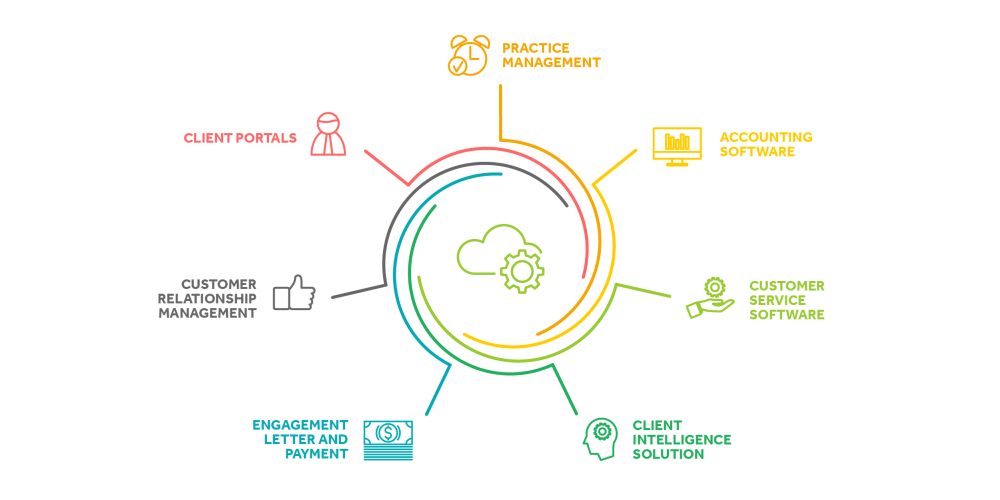*This blog is part of the September Thought Leader newsletter.
 Once upon a time, the tax and accounting profession’s tech stack consisted of the Microsoft Excel spreadsheet and a One-Write Plus software application (I bet that takes you back a few years). And it was good.
Once upon a time, the tax and accounting profession’s tech stack consisted of the Microsoft Excel spreadsheet and a One-Write Plus software application (I bet that takes you back a few years). And it was good.
Then software vendors popped up everywhere, solving individual problems like tax preparation, client accounting, payroll and the like. Still good, since it was more efficient—even though there were more solutions to manage.
But then…enterprising software companies created the concept of the tax and accounting suite, which consisted of individual applications to cover just about every aspect of running an accounting firm in that simpler time. Those applications all worked (somewhat) together to keep things humming along day to day. And it was even better.
However, while technology kept evolving, the suites didn’t always keep up. As a result, we’ve seen a surge of new point solutions: Next-generation tools that help firms solve a specific friction point not being addressed by the suite solutions. It started with practice management and the need for a better customer experience. But from there, it’s only expanded—client portals, customer relationship management (CRM), client intelligence, client payments, proposals, e-sign, document exchange. Today, there are point solutions for just about everything.
And frankly, it’s crazy.
Why crazy? Well, firms have gone a bit app-happy—driving up their software costs and creating multiple databases in the process. Don’t get me wrong; it’s great to have choices, but I’m seeing firms that are using as many as two dozen separate tools. That’s at least 24 vendors to deal with, 24 fees to pay, 24 apps to learn and 24 logins (multiplied by the number of staff) to juggle.
The future of firm management
When we talk about becoming a modern accounting firm, a major part of the goal is to make your life easier. That’s why the goal for a modern firm’s tech stack should be to minimize and streamline the number of tools you use. A manageable number of tools, purchased from vendors you trust, will be there and prepared to grow with you over the coming years. A single client database and the right firm management systems—CRM, proposals, portals, client communications, client intelligence, document management, payments—all in one space, in one place.
Earlier this year, I wrote an article on how traditional practice management isn’t working. I mentioned that getting the holistic approach to running a modern firm right can be like building a puzzle. That’s truer than ever, given the number of point solution applications out on the market now.
Think about what you’re using in your current practice management tech stack. To help you out, here are the functions that should be available in each category:
Practice management
- Contact management
- Time and billing
- Workflow tracking
Customer relationship management
- The ability to track prospective clients.
- The ability to nurture prospects through the process of becoming a client.
Client portals
- Sending and receiving documents.
- Obtaining e-signatures.
- Receiving payments.
- Collaborating with clients on tasks and questions.
Customer service software
- Centralized customer service ticketing
- Firm communication management
- Reporting capabilities
Engagement letter and payment
- A streamlined engagement letter process.
- Automated billing and payment for services provided.
Client intelligence solution
- The ability to collect and consolidate clients’ financial, technology and business data.
- The ability to analyze and use the data for proactive client advisory.
Accounting software
- Perform client accounting work (more than likely, this will be some form of QuickBooks®).
I’m starting to see a couple of modern firm management solutions emerge—capable of one database, providing the necessary functionality noted above. What I’m also seeing is the need to reexamine how “practice management” has now evolved into “firm management,” and how the point solutions functionality is now being included in some of the more comprehensive firm management solutions.
In addition, I’m seriously questioning the future need for point solutions—those individual solutions that add more complexity to your tech stack.
Everything old is new again…
It seems to me we’re now back to where we started. The individual solutions with focused functionality are now being incorporated into the firm management suite. And just like 25 years ago, when we made the decision to leverage the suite concept, it may be time to do that again.
Except this time, how we think about the suite will look a little different—and I’m excited to see what comes out of that new kind of thinking. How about you?



